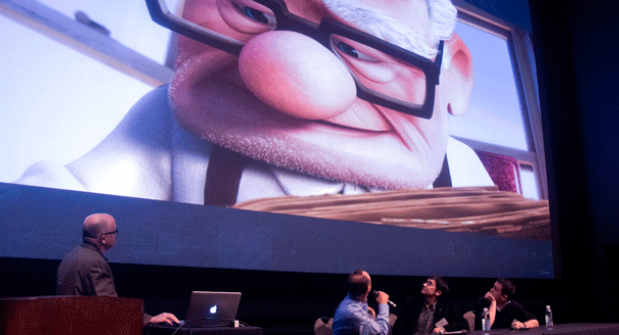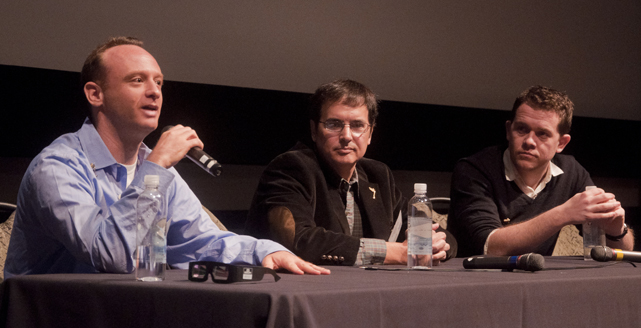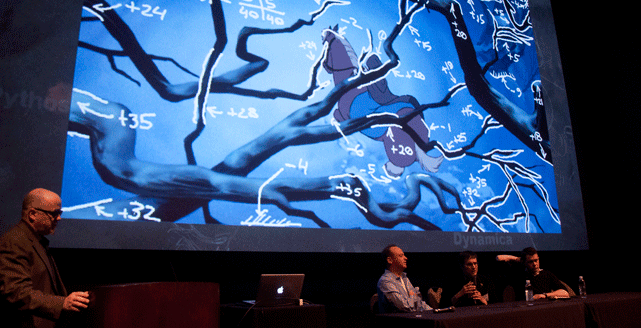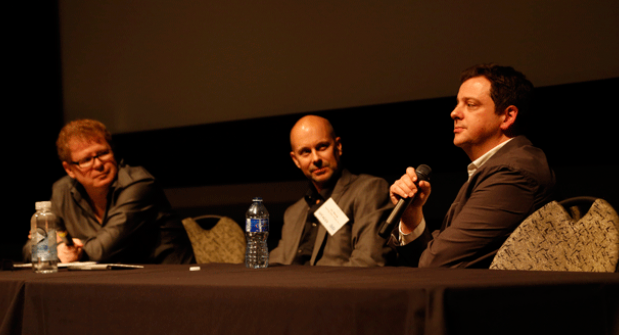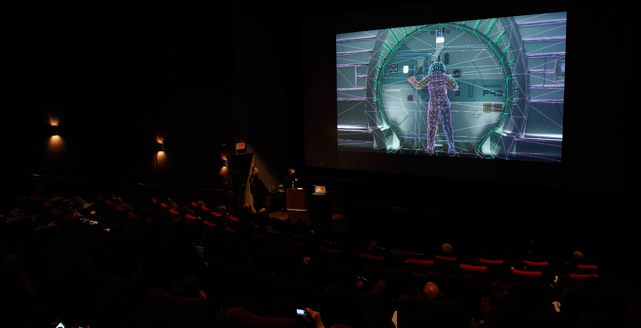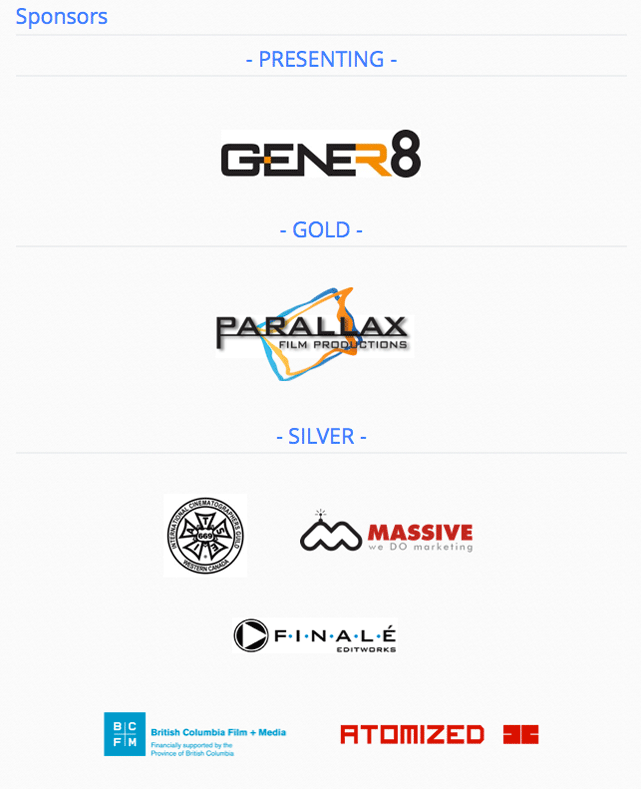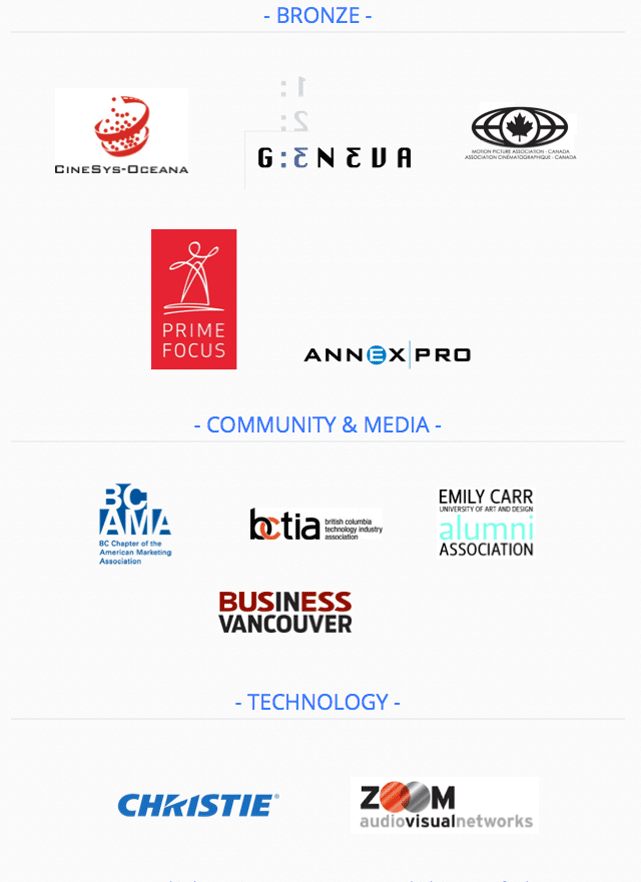This is PART 2 of 3 Recaps for the 3D[FWD] Conference and Networking Reception. Go here for PART 1
Session 3: PANEL: Telling Your Story in 3D with Adam May, Vision 3; Robert Neuman, Disney; & Joshua Hollander, Pixar | Moderator: Buzz Hays, True Image Co.
We watched clips from Pixar’s “Brave”, Disney’s “Tangled” and a compilation of Vision3’s project to kick off this panel session, with all three being extraordinary in immersiveness and 3D skill. The scene from “Tangled” called ‘Lanterns’ was the recipient of Scene of the Year at the Society’s 2nd Annual 3D Creative Arts Awards, and it was clear how this scene won by a landslide. It had every checklist element of 3D one could wish for 1) good character roundness, 2) 3D that flowed seamlessly between positive and negative parallax and 3) interesting story elements that took advantage of the very nature of 3D.
Neuman entered the industry wondering how 3D could be used as another tool in the cinematographers’ tool belt, and what the 3D grammar/language would look like. He created a 3D language for Disney and began working in 3D in “the most organic part of the creative process of the film as we could”. “The 3D you see isn’t just the literal stereoscopic geometry between the left and right camera, it is often composed of 8 stereo layers that include the characters and environment”.
Hollander: “We wanted to resurrect some of our old titles at Pixar, and see what that would look like. As a result we got approval to do “Up” in 3D, and we started an aggressive testing, experimentation, and education campaign in the company. In the beginning we kept the 3D subtle in those early days, and since then as our understanding and sophistication of the medium has increased, we are doing more multi-cam and involved 3D usage”.
Hays: “Underneath all this technical talk, 3D is considered an art form. We concentrate on NOT overwhelming people with technology and focus rather on the use of 3D in story.”
All four panelists discussed the use of convergence as a subtle tool, and how each of them approaches convergence with interaxial. Neuman states that he looks always at comfort first, and also what the main subject is. He stated that he tracks the viewers natural focus point as close to the screen (converged upon at the screen plane) as possible. May discussed his approach in live action, and how nothing can truly be fixed and 100% controlled on a shoot. But he did state that as a general rule, they try to converge on the furthest point in a room. “It ticks two boxes. When shooting converged, it is an immediate 3D reference on the shoot, but also you still have some level of flexibility in post production”. In terms of editing, May explained too that they reduce the depth in faster cut sequences and use depth in a rhythm with the edit pace for the story. He utilizes depth scripting considerably, not too dissimilar to how animated films operate. Hollander explained their influence at Pixar from scientist Archibald Stanley Percival’s’ philosophy of the ‘zone of comfort’, and how the ocular system operates with physical space. “We converge on where the audience is focusing, and use negative and positive parallax for emotional impact.” Hollander describes a terrific scene from “Up” where 3D is used with colour to create incredible emotional impact on the audience. As the scene progresses, the colour saturates and the 3D depth increases coinciding with edit cuts. This was a terrific example of how 3D not only improves upon, but also in some cases creates an emotional intensity not otherwise possible without 3D.
“Thanks for having me up there for 3D[FWD]. I really enjoyed the panel and all of my informal conversations.” – Joshua Hollander, Director of 3D Production, Pixar Animation Studios
One point often brought up was how 3D depth can be used like a musical score. Neuman in particular demonstrated the incredible level of detail that the Disney team goes into with the stereo grading on each shot, and how the shots together create a linear ‘score’. In live action, May said, “we don’t have the same level of control. But we absolutely use 3D like a soundscape and a reference when we talk about 3D, and its emotional arcs.”
Hays states “There is a lot to talk about with the creatives on this topic. And sometimes you have to explain this to a non-creative, who isn’t as passionate about 3D. 3D should never be an afterthought, because you are not taking into consideration the framing, the depth, the emotional aspects that 3D can create.” He went on to say “there are more bad 2D movies than 3D. But 3D is the new kid on the block, so you feel like you can punch him in the gut when you need some validation.” Hays promoted experimentation if it is possible prior to a project as a safe place to make errors and figure out what will work with the project. He also explained how directors like Baz Luhrmann and Robert Zemeckis were able to see the potential of 3D to become an intimate and emotional contribution to a story, and add a new level of creativity to the film.
We were able to view some of Vision3’s 2012 Olympic indents, which were truly breathtaking in not just 3D, but also shot at high speed for slow motion. We also watched a short by Pixar, called “Night and Day” which takes advantage of 3D in one of the most unique ways yet
“Congratulations in organising a brilliant 3D conference, I thought it was incredibly well organised and the attendees certainly came away with a lot!” – Adam May, Head of Production Vision3, UK
Session 4: PANEL: Is 3D Production a Fool’s Errand or the Road to the Future?with James Cowan, Finale Editworks & Ian Herring, and Parallax Films | Moderator: James Stewart, Geneva Films
Parallax Films showed some clips from “Blowdown”, “Battle Castle”, and an upcoming graphic novel they are creating. Cowan stated that “3D in Vancouver has had a bit of a love and hate relationship. As a major production Centre, we were inundated with feature film work that used US 3D crews. Som many people here haven’t had their services used even yet.” On “Piranha 3DD”, Cowan completed all the 3D post production on the film with Technicolor in Vancouver. Ian Herring had great information for the audience about their “Blowdown” structural implosion project in 3D of a major football stadium in Brazil. He spoke to the difficulty and also perfect storm of conditions that led to working with a demolition team for National Geographic, and being able to test their 3D pipelines simultaneously with National Geographic. In their 3D episode of “Blowdown”, they had to build actual custom 3D capture systems and also used a Canon 5D beam splitter, many security cameras, and manage to edit the content form these systems seamlessly together. Cowan echoed this by discussed the challenges doing DI and stereo grading on “Piranha 3DD” due to having so many multiple camera systems including Red cameras. He explained their process for making the mixed content balanced not only in colour, but also balanced in stereo.
Herring mentioned with “Battle Castle” that they were able to pitch the idea of shooting it in 3D, and once approved they were able to use better 3D equipment and green screen stages. During the process, the 3D hype started to taper off and instead of doing an agreed three episodes in 3D, the network only ended up doing one. Herring explains that the networks were concerned about making money, and “coming in from Blowdown, we already had a structure in 3D. But for someone coming in cold, I am not sure how anyone would have done that”. From an independent producers point of view, Herring explained how to negotiate for 3D: “As a Canadian, we land of Canadian 2D deal first. We go to Shaw cable, for example, then carve out 3D. Then we take this model down to 3net to get financed that way. This is in fact, a VERY workable model, and I am surprised that more Canadians are not doing this. With that anchor broadcaster in place you can bring in $400,000 or so, then go to the US and pick up $100,000 more. There is no guarantee it will pick up, as it must not only fit America’s needs, but also International needs.” Herring explained his enjoyment of the latest fixed interaxial Sony cameras and how you can shoot native 3D, and also provide 2D content from it. Stewart explained how Toronto has good 3D resources such as 3D rigs and these are available for rent to Vancouver. Cowan explained how Vancouverites have an excellent talent base, and are highly educated on working on 3D projects. He explained that several companies including Finale that are 3D ready, and available to support a project, which echoes what Herring stated which is: “Canada can do 3D”.
“We were so impressed by the level of talent and interest.” – Don Thompson, President/Founder Finale Editworks
Session 5: 3D Conversion: The State of the Art & Debunking the Mystery with Mark Lasoff & Colin Jenken, Gener8
“Every single frame of that started from 2D,” starts Mark Lasoff after their sizzle reel finishes. For the kind of projects Gener8 completes, there is a large VFX component to the film- so Gener8 works not only of converting 2D capture, but also completes VFX shots. Lasoff continues that they get three kinds of films; 1) 2D that needs to be converted to 3D, 2) films shot in native 3D but for cost reasons included 2D with the intent on converting, and 3) native 3D shots that need to be converted due to errors or re-shoots.
Gener8 is composed of some extremely gifted personell. Lasoff himself has won Academy Awards for his VFX work, and Jenkin has worn many hats in this idustry, having also created some of Gener8’s pipelines and software. They have a common goal at Gener8, and Lasoff describes how inside Gener8, they believe the stereographer must be included throughout the process from start to finish. Using their depth assessment process, they continue on to match move of camera, rotoscope, then rotomation. At the very end, they project the frame onto their models. The Gener8 team demonstrated on their proprietary software Stereo Composer this entire process, which eventually ends in final approval to the client. Lasoff continues to state that the entire stereo conversion process is some simultaneously to the VFX pipeline, which is what truly sets Gener8 apart from their competition.
Colin Jenkin explains how this is what enables Gener8 to deliver quicker than their competition and with the best quality of image possible. Jenkin showed some clips from Ghost Rider: Spirit of Vengeance that demonstrates how the VFX looks when worked at the same time as the actual conversion, all the way to the final shot. “We really based our pipeline around the stereographer,” states Jenkin. “Simple convergence and IA can be adjusted in real time rendering.”
On Prometheus, Gener8 had to match the converted footage to match what the excellent native 3D appeared to be. Most of the work done on this project was to correct occlusion, and it was natural to create depth continuity. Whether converting is more affordable than shooting native 3D is completely debatable at this time (hint: it depends on many variables) but there is one thing very obvious: as they continue to put research and develop into their tools, there is no doubt that Gener8’s process will become even more affordable.
Continue onwards to PART 3 of the Recap
Parallax films has a fantastic review on their website, as well as one of our most favourite moments from the movie “Honeymooners”. A highlight of their review:
James (Stewart) provided us all with the talking points to sell our media form, reminding us all that if 3D is a fad, it is a 227.27 BILLION dollar fad, that is growing at 15% per year. – Parallax Films
Thank you to all of our speakers, sponsors, and of course the attendees for helping us make an incredible landmark event! Please visit the Chapter Website in February for more information. Don’t forget to follow us on Twitter, @EmilyCarrS3D and @_MassiveMedia to see the live Tweets of the event and stay up to date with the next events. Again if you wish to become a member, contact us through Twitter, or our direct email.
